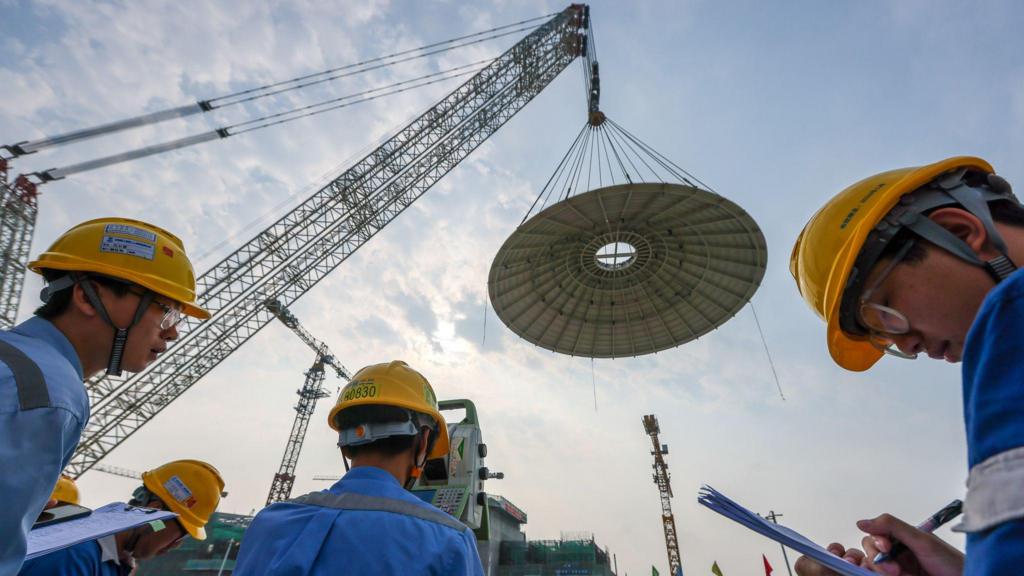Rolls Royce has been awarded the contract to design and construct the UK’s first small modular nuclear reactors (SMRs).
These SMRs are anticipated to address the UK’s rising energy demands, offering a faster development timeline than traditional large-scale reactors and generating thousands of skilled jobs.
This £2.5 billion investment in SMRs complements a separate £14.2 billion government commitment to build Sizewell C, a larger nuclear reactor in Suffolk.
SMRs, sometimes referred to as “mini nukes,” operate on the same principle as larger reactors, harnessing nuclear fission to generate electricity.
Within one or more reactor vessels, nuclear fuel atoms undergo fission, releasing significant heat. This heat converts water into steam, driving a turbine—essentially, a giant nuclear boiler.
SMRs will be substantially smaller than conventional reactors, possessing up to one-third of their generating capacity.
Their modular design allows for factory construction—as prefabricated components—followed by on-site assembly, akin to a flat-pack power station.
This approach aims to reduce both time and costs.
The government’s goal is to establish a secure, reliable, affordable, and low-carbon energy system.
In 2024, nuclear energy accounted for 14% of the UK’s electricity generation (provisional government figures), a share the government aims to increase significantly.
Alongside 30 other nations, the UK has pledged to triple its nuclear capacity by 2050.
However, no new nuclear power station has been built since Sizewell B commenced operations in 1995, and most existing plants are slated for decommissioning by the end of the decade.
The SMR industry is still in its nascent stages, with approximately 80 designs under development globally.
Currently, only China and Russia have operational small modular reactors.
The UK government is confident that, with sufficient investment, SMRs will create numerous jobs and stimulate manufacturing.
Initially, however, a combination of public and private investment will be crucial to achieve commercial viability.
In the US, tech giants including Google, Microsoft, and Amazon, driven by their energy-intensive data centers, have committed to utilizing SMRs upon their completion.
In 2011, the Conservative government identified eight potential sites for larger nuclear reactors.
Then, in February 2025, the prime minister announced plans to streamline planning regulations to facilitate the construction of SMRs at additional locations.
Specific criteria will apply, excluding sites near airports, military installations, or pipelines, as well as environmentally sensitive or flood-prone areas.
Great British Nuclear, a public body, conducted a competition to select an SMR developer.
It aims to announce a site by the end of 2025, with the first SMR operational by the mid-2030s.
Potential locations include former industrial sites, such as decommissioned nuclear plants or coal mines, situated near the electricity grid.
Rolls Royce emerged victorious, outcompeting two American consortiums and a Canadian firm.
The financial challenges encountered by Hinkley Point C highlight the UK’s motivation to adopt a different approach. The project has experienced significant delays and cost overruns.
SMRs promise faster, simpler, and more economical construction.
However, substantial cost savings are projected only after design finalization and mass production.
Consequently, the initial SMRs will likely be expensive.
Nuclear waste management costs must also be considered. Sellafield, currently handling most UK waste, is nearing capacity, and costs are escalating.
In 2024, a government advisory committee recommended that new reactor designs incorporate comprehensive waste management plans to avoid past mistakes.
Taxpayers continue to bear the costs associated with Sellafield’s management of waste dating back to the 1950s.
Nuclear experts interviewed by the BBC believe that SMRs and increased nuclear power generation will eventually lower electricity costs.
Public perception of nuclear power seems correlated with electricity prices. A 2024 government survey indicated that 78% of respondents would be more accepting of energy projects if offered bill discounts.
While the government has announced bill discounts for households near upgraded pylons, no such initiative has been announced for SMR-adjacent communities.
The International Atomic Energy Agency considers nuclear power plants to be among the safest and most secure facilities globally.
However, high-profile accidents, such as Chernobyl (1986) and Fukushima (2011), have negatively impacted public perception.
Dr. Simon Middleburgh, a nuclear scientist from Bangor University, describes the UK’s proposed SMRs as “incredibly safe”.
He highlights the UK’s Office for Nuclear Regulation (ONR) as a globally recognized leader in nuclear safety regulation.
Nevertheless, concerns persist regarding nuclear waste management. Government advisory groups have noted that the issue of radioactive waste from SMRs “appears, with some exceptions… to have been largely ignored or at least downplayed”.
The number and location of SMRs also present security considerations.
Dr. Ross Peel, a researcher in civil nuclear security from King’s College London, suggests that the decentralized nature of SMRs, potentially situated in urban or industrial areas, will increase security challenges compared to existing large-scale plants.
Security at nuclear power plants is currently provided by armed police (Civil Nuclear Constabulary). Dr Peel notes that the isolation of existing sites facilitates security operations, while urban or industrial settings present new security challenges.
Scotland has reduced its emissions by 51.3% since 1990, representing a 1.9% annual decrease.
Sir Keir Starmer projects that Sizewell C will create 10,000 jobs over the next decade.
The chancellor terms it a “landmark decision,” but critics question the project’s ultimate cost.
A Scottish minister confirms the SNP’s continued ban on new nuclear plants through devolved planning powers.

